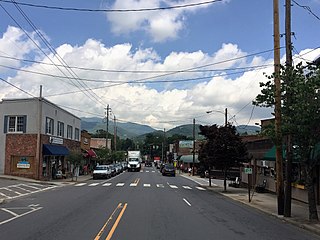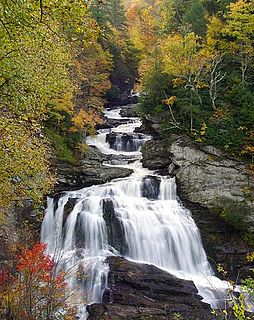
Macon County is a county located in the U.S. state of North Carolina. As of the 2010 census, the population was 33,922. Its county seat is Franklin.

Black Mountain is a town in Buncombe County, North Carolina, United States. The population was 7,848 at the 2010 census. It is part of the Asheville Metropolitan Statistical Area. The town is named for the old train stop at the Black Mountain Depot and is located at the southern end of the Black Mountain range of the Blue Ridge Mountains in the Southern Appalachians.

Abingdon is a town in Washington County, Virginia, United States, 133 miles (214 km) southwest of Roanoke. The population was 8,191 at the 2010 census. It is the county seat of Washington County. The town encompasses several historically significant sites and features a fine arts and crafts scene centered on the galleries and museums along Main Street.

Highlands is an incorporated town in Macon County in the U.S. state of North Carolina. Located on a plateau in the southern Appalachian Mountains, within the Nantahala National Forest, it lies mostly in southeastern Macon County and slightly in southwestern Jackson County, in the Highlands and Cashiers Townships, respectively. The permanent population was 1,014 at the 2020 census.

North River Mills is a historic unincorporated community in Hampshire County in the U.S. state of West Virginia. North River Mills is located between Capon Bridge and Slanesville on Cold Stream Road at its intersection with North River Road. The village of North River Mills lies along the eastern banks of North River from which it takes its name.

The John C. Campbell Folk School, also referred to as "The Folk School" is located in Brasstown, North Carolina, along the Cherokee County and Clay line. The school was founded to nurture and preserve the folk arts of the Appalachian Mountains. It is a non-profit adult educational organization based on non-competitive learning. Founded in 1925, the Folk School's motto is "I sing behind the plow".

This is a list of the properties and historic districts in each of the 46 counties of South Carolina that are designated National Register of Historic Places.

The Nantahala National Forest, established in 1920, is a national forest located in the American state of North Carolina. The word "Nantahala" is a Cherokee word, meaning "Land of the Noonday Sun." In some spots, the sun reaches the floors of the deep gorges of the forest only when it is high overhead at midday. This was part of the homeland of the historic Cherokee and their indigenous ancestors, who have occupied the region for thousands of years.

Oconaluftee Archeological District is within the eponymous river valley in the Great Smoky Mountains of North Carolina, located in the Southeastern United States. Formerly a historic Cherokee village, followed by an Appalachian community, were located at this site along the Oconaluftee River. Now the site serves as the main entrance to the North Carolina side of the Great Smoky Mountains National Park.

The Church of the Incarnation built in 1896 is a historic Carpenter Gothic Episcopal church building located at 111 North 5th Street in Highlands, Macon County, North Carolina.

This list includes properties and districts listed on the National Register of Historic Places in Wilkes County, North Carolina. Click the "Map of all coordinates" link to the right to view an online map of all properties and districts with latitude and longitude coordinates in the table below.

Penland is an unincorporated community in Mitchell County, North Carolina, United States. Penland is 2.9 miles (4.7 km) west-northwest of Spruce Pine. Approximately 200 year-round residents live in the community, the center of which is the Penland Road bridge crossing the North Toe River and CSX railroad line.

The Baldwin-Coker Cottage is a historic house at 266 Lower Lake Road in Highlands, North Carolina. The Rustic-style 1-1/2 story log house was designed and built in 1925 by James John Baldwin, an architect from Anderson, South Carolina. The cottage is important as a prototype for a number of later houses that were built by members of the construction crew. The walls are constructed of notched logs, whose ends project at random-length intervals, both at the corners of the house, and from the interior, where logs are also used to partition the inside space. The house is topped by a side-gable wood shingle roof. The main gable ends, and the gables of the dormers, are clad in board-and-batten siding. A porch with naturalistic limb-and-twig railings spans the width of the main facade.

Cabin Ben is a historic log house at 115 Cullasaja Drive in Highlands, North Carolina. The house consists of two rectangular sections, joined at an offset. The smaller of the two sections houses a large living room, while the larger section houses the kitchen, dining, and bedroom areas. The house was designed by Clemson University professor of architecture Rudolph Edward Lee for a family friend, Miss Anne England, and was built in 1932 by Joe Webb, a locally prominent builder of log houses. It is a relatively unaltered example of Webb's work, having been designed to house relatively large family gatherings. It has remained in the hands of England descendants.

The Hall Cabin, also known as the J. H. Kress Cabin is a historic log cabin in Great Smoky Mountains National Park, about 15 miles (24 km) from Fontana, North Carolina. The cabin is a rectangular split-log structure 24 feet (7.3 m) wide and 17 feet (5.2 m) deep, with a porch spanning its front. The gable ends of the roof are sheathed in board-and-batten siding. It was built by a man named Hall in 1910, and underwent some remodeling around 1940 when J. H. Kress used it as a hunting lodge. It is located in the drainage of Hazel Creek, an area which historically had a small population and was abandoned after the construction of Fontana Lake and the national park. It is the only structure remaining in its immediate vicinity.

The Playmore–Bowery Road Historic District is a residential historic district composed of a collection of summer resort houses in the hills east of Highlands, North Carolina. The principal estate in the area, called Playmore, was established by the Ravenel family in 1879-80; it is situated on 140 acres (57 ha) south of Horse Cove Road. Bowery Road roughly parallels Horse Cove Road to the north, and is lined with a series of wood-frame summer that were built between about 1880 and 1930.

The Wilson Log House is an historic house in rural Macon County, North Carolina. It is a single story log structure, located west of Highlands, on the west side of State Route 1621, 1.4 miles northwest of its junction with Route 1620. It was built c. 1882 by Jeremiah Wilson, and is one of a small number of period log buildings to survive in the county. The house remained in the Wilson family until the 1950s. It measures about 18' by 20', and is constructed from logs with dovetail joins, and red mud chinking. Its interior consists of a single large chamber, with a stair rising on one side to a loft area under the gable roof. At some point a frame addition was added to the rear of the house, but that has since been removed.

Valhalla Highlands Historic District, also known as Lake Valhalla, is a national historic district located near Cold Spring in Putnam County, New York. The district encompasses 57 contributing buildings, 11 contributing sites, 10 contributing structures, 7 contributing objects and a 900-acre forest in an early second home community established by primarily German/Austrians and Norwegians from New York City. It developed between the early-1930s and mid-1940s, and includes lodges that are typically one or two stories high and have fieldstone foundations. They are characterized by structural stone walls and full log construction and frame dwellings clad with half-log wood siding and fieldstone veneer, chimneys and terraces. The district also includes a boat lodge with a ping-pong room and terrace, a swimming dock, a boat dock, a tea pavilion, a recreation pavilion, a lookout pavilion, shuffleboard courts, a tennis court, a playing field, a picnic area, rustic improvements throughout the forest and the remnants of a hunting cabin.

Foster's Log Cabin Court is located at 330-332 Weaverville Road in Woodfin, North Carolina, about five miles north of the City of Asheville. One of the first auto-oriented tourism facilities in the Asheville area, it features a number of one and two bedroom Rustic Revival log cabins and a dining lodge. It was placed on the National Register of Historic Places in 2017.





















